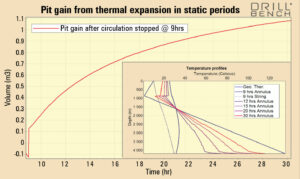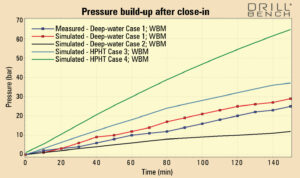Impact of thermal expansion on kick tolerance should be part of pre-drilling risk assessment
By Inge Mosti, Bjørn-Tore Anfinsen, Anne Sofie Flatebø, SPT Group
Expansion of drilling fluid due to geothermal heating is a well-known effect. However, it has been difficult to quantify with software simulations because it requires very accurate modeling of downhole temperature conditions during operational changes.
In the case discussed in this article, a pit gain was observed at surface after shutting down the pumps during normal drilling operations. The well was closed according to rig procedures, and a pressure increase was observed in the shut-in well. No other indication of a kick was observed during the continuing well control operations.
SPT Group was approached with the case, and post analyses were carried out with the Drillbench Dynamic Hydraulics software. When replicating the operational sequence prior to and during the event, simulations showed that a pressure increase due to thermal expansion could be expected when the well was shut in. The simulated pressure build-up showed a good match with the build-up observed on the rig.
Introduction
The increasing complexity of drilling operations is often associated with extreme pressure and temperature conditions combined with harsh operating environments. The associated risks due to small margins, high investments and a strong focus on safety during the execution of a drilling project calls for more detailed planning. This requires a thorough understanding of downhole processes during all phases of a drilling operation, as well as knowledge of how changes from one operational regime to another will change the corresponding well behavior.
If the normal well behavior is misinterpreted, it could lead to unnecessary operations and result in costly rig time or, in the worst case, could challenge well integrity. Kick tolerance calculations and ECD calculations are a crucial part of the planning phase. To correctly assess these, variations in the downhole temperature must be considered.
Thermal expansion
In high-pressure, high-temperature and deepwater conditions, there typically will be considerable temperature variations in the well during normal drilling operations. The most extreme changes in temperature are normally seen in the transition from circulating conditions to geothermal conditions during static periods.
While circulating, there is generally a cooling of the lower part of the wellbore as cold mud is pumped down the drillstring, and a heating of the upper part as warm mud from bottom is circulated up. When the circulation stops, the circulating temperature profile will return towards geothermal conditions. This involves heating of the drilling fluid in the lower part of the wellbore and a cooling of the drilling fluid in its upper part. The effects of these two processes counteract each other, and, depending on initial conditions at the onset of the static period, one or the other could be dominating.
If the prevailing effect is heating and the average temperature in the wellbore is increased during this transition, the heating of the mud will cause thermal expansion. This expansion will result in a pit gain at surface, e.g. during connections or flowchecks.

The simulation run in Figure 1 illustrates the above example. This case shows a vertical deepwater well drilled to approximately 4,200 m. The water depth is around 800 m, with the wellhead at seafloor. The openhole section below the 9 5/8-in. casing shoe at 4,100 m is drilled at 6 m/hr with a flowrate of 2,100 l/min. After 9 hrs of operation (4 hrs circulation and 5 hrs drilling), the circulation is stopped and the well is left static.
The circulating temperature profile just prior to stopping circulation (at 9 hrs simulation time) is shown in the plot. The circulating temperature showed a reasonable match with available measured data. In the simulation, it can be seen how the temperature profile along the wellbore changes towards the geothermal temperature.
The main frame shows the corresponding pit gain as a result of the thermal expansion of the mud: After 21 hrs static, this expansion contributes to around 1 cu m pit volume gain. The gain rate at this time is decreasing, but it is interesting to observe that still after 21 hrs static, the geothermal temperature is not yet reached in the wellbore. If the well is shut in during this static period, the thermal expansion of the drilling fluid in the closed well will cause a pressure build-up in the well.
During field operation, the example well was actually shut in, and the corresponding simulated pressure increase from thermal expansion is shown in Figure 2 (Case 1). There is a good correlation between the simulated pressure increase and the actual casing pressure measured on the rig during the shut-in period. The pressure build-up after 2.5 hrs shut-in time is around 25 bars.
Simulations were also performed for:
• Case 2: Deepwater well with water-based mud at 1,250 m water depth and 8 ½-in. openhole to 3,800 m (vertical).
• Case 3: HPHT well with water-based mud at water depth 380 m and 8 ½ in. openhole to 5,700 m measured depth (deviated).
• Case 4: HPHT well with oil-based mud at shallow water and 12 ¼-in. openhole to 5,000 m (vertical).
All of these cases showed a potential for pressure build-up due to thermal expansion when shutting in the well during static periods. The operational sequence for all cases is the same prior to the static period, with 4 hrs circulation followed by 5 hrs drilling prior to stopping the pumps.

Figure 2 shows a significantly different pressure build-up from case to case. This variation is due to different operational parameters, different well geometries and different drilling fluid properties. The HPHT Case 4 shows the highest pressure build-up to 65 bar pressure after 2.5 hrs. This is a comparatively large pressure build-up, and the difference is most likely due to the well being drilled in the 12 ¼-in. section down to 5,000 m depth. Higher formation temperature and a larger volume available for heating and expansion, compared with the 8 ½-in. openhole section for the other cases, lead to a higher pressure build-up. It is also the only case in this comparison with oil-based mud, which has a different compressibility and a larger potential for thermal expansion than water-based mud.
The dependency on these different parameters makes it difficult to compare and generalize from case to case. The temperature profile at the onset of the static period will be dependent on the operational sequence leading up to the point when circulation stops. In order to predict normal well behavior, it is necessary to accurately account for temperature variations in the wellbore prior to and during static periods in the well. This can be accomplished with dynamic simulation models that can account for changes in the operational parameters with time.
Kick tolerance
Kick tolerance is usually associated with the volume of influx that can be shut in and circulated to surface without exceeding well design strength and surface equipment capacity. However, the case examples given here show that focusing on the pressure caused by the influx volume alone may not be sufficient. If the possibility of thermal expansion is identified through simulations during the planning, this should also be part of the kick tolerance consideration for the project.
The well in Case 1 was drilled with 1.60-sg mud density in the 8 ½-in. section when the well was shut in. Using basic well control theory (assuming formation pressure equal to the hydrostatic pressure from the mud column), a reduction of the hydrostatic column giving a shut-in pressure of 25 bars would be equivalent to approximately 4 cu m influx of gas in a vertical 8 ½-in. section.
In narrow-margin wells, this would be a significant reduction of the kick tolerance. For the reservoir section, the casing shoe is typically set close to the reservoir. Kick tolerance with regards to shoe strength in the reservoir section is therefore often not as critical, considering the influx volume. In the event of a kick, the influx will reach above the shoe, hence balancing the increased shut-in pressure by a reduction in the hydrostatic column above the shoe. However, if the additional pressure contribution from thermal expansion is included, this could have significance for the kick tolerance considerations.
In a real kick situation, it’s important to know the correct shut-in pressures in order to make the right operational decisions. Distinguishing between pressures caused by the influx and the pressure contribution from the thermal expansion is very important in such cases.
Conclusion
Thermal expansion can be significant in wells with large temperature variations during drilling operations. The pressure increase in a shut-in well caused by this expansion can be significant for the well’s kick tolerance and should be part of the risk assessment prior to a drilling operation. In order to maintain safe drilling practices and make the correct decisions in case of unexpected events in the well, it is of great importance to know and understand a well’s normal responses. Dynamic simulations can quantify the effect of geothermal heating and make it possible to include and account for these effects, both in the planning and execution of the drilling operations.
About the authors: Inge Mosti holds a masters degree in geology from the University of Bergen. He is a senior consultant with SPT Group, studying dynamic well control and dynamic hydraulics and temperature effects. Bjørn-Tore Anfinsen holds a masters degree in petroleum engineering from the Norwegian University of Science and Technology. He is now SPT Group executive vice president for the Drillbench business unit. Anne Sofie Flatebø holds a masters degree in chemical engineering from the Norwegian University of Science and Engineering. She is a senior consultant at SPT Group, performing studies in dynamic modeling of flow assurance, dynamic well control and dynamic hydraulics and temperature effects.
This article is based on a presentation at the IADC Well Control Europe Conference & Exhibition, 9-10 April 2008, Amsterdam.
